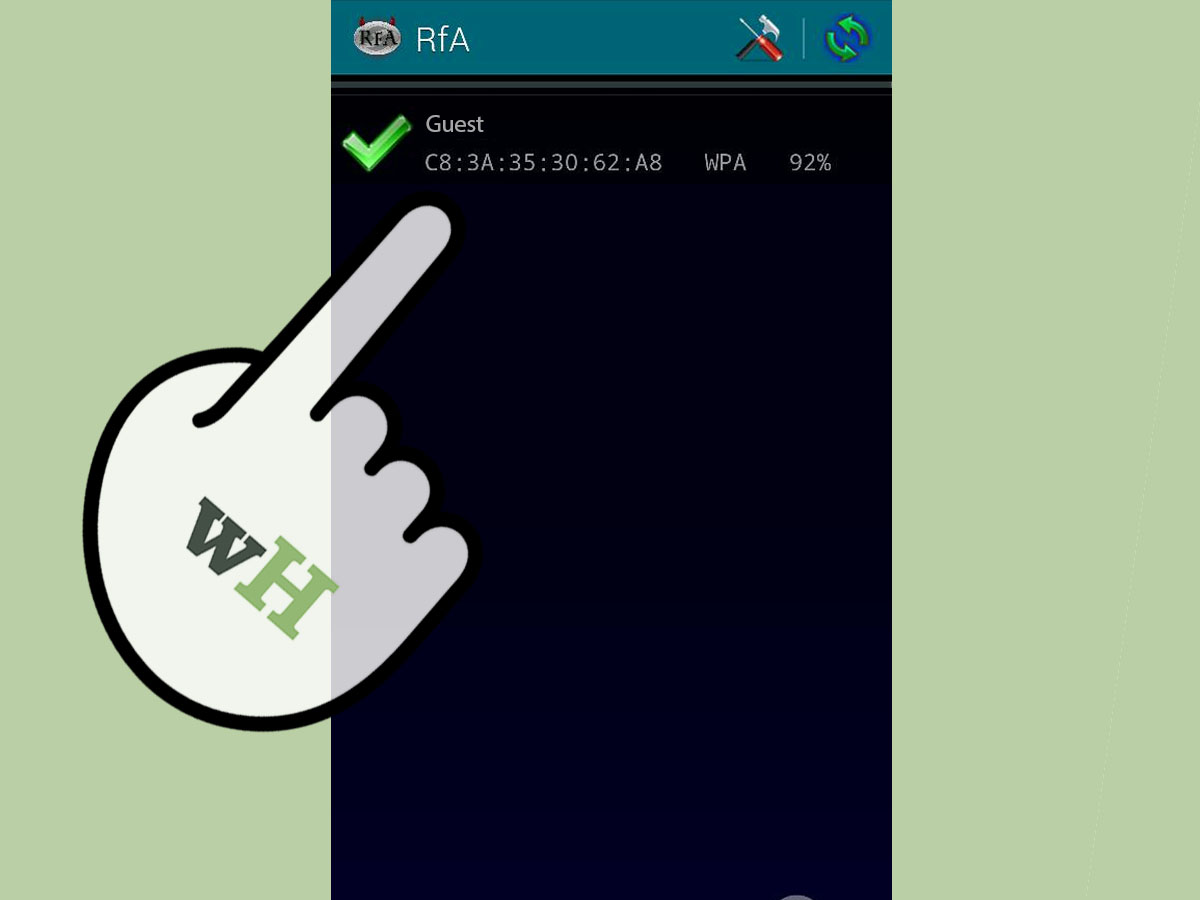Introduction
Welcome to the world of Wi-Fi hacking on your Android tablet! If you’ve ever found yourself in a situation where you desperately need to connect to a Wi-Fi network but don’t have the password, this article is here to help. While hacking Wi-Fi passwords may sound like a complex and illegal activity, there are legitimate reasons for wanting to gain access to a network you have permission to use, such as recovering a forgotten password or troubleshooting network issues.
Before we dive into the step-by-step process of hacking Wi-Fi passwords on your Android tablet, it’s important to note that this guide is intended for educational purposes only. It is essential to respect the privacy and security of others, and it is illegal to hack into someone’s Wi-Fi network without their permission. Always make sure you have the proper authorization before attempting to hack a Wi-Fi password.
To get started with Wi-Fi hacking on your Android tablet, there are a few precautions you should take. First, ensure that you have rooted your tablet. Rooting gives you administrative access to your device, allowing you to perform actions that are typically restricted. Keep in mind that rooting your tablet may void your warranty and can potentially cause security risks if not done correctly, so proceed with caution.
Once your tablet is rooted, you’ll need to download and install a Wi-Fi hacking app. There are several options available, but make sure to choose a reputable and trusted app from a reliable source to minimize the risk of malware or security breaches. It’s always a good idea to read reviews and do some research before installing any third-party apps on your device.
With the necessary precautions in place, you’re ready to move on to the step-by-step process of hacking Wi-Fi passwords on your Android tablet. Follow the instructions carefully, and remember to use this knowledge responsibly and legally. Let’s get started on our Wi-Fi hacking adventure!
Precautions before attempting to hack Wi-Fi passwords
Before you dive into the world of Wi-Fi hacking, it’s important to take some precautions to ensure that you are acting responsibly and ethically. Hacking into someone’s Wi-Fi network without their permission is illegal and a violation of their privacy. Keep in mind that this guide is intended for educational purposes only, and it is essential to obtain proper authorization before attempting to hack a Wi-Fi password. Here are some important precautions to consider:
1. Legal and ethical considerations: Make sure you have the legal right and explicit permission to access and hack the Wi-Fi network you want to target. Hacking into a network without permission can have serious consequences, including legal action and potential criminal charges. Always adhere to the laws and regulations in your jurisdiction.
2. Use your own network: It is highly recommended to practice Wi-Fi hacking techniques on your own network or with explicit permission from the network owner. This avoids any legal issues and ensures that you are not intruding on someone else’s privacy.
3. Research and understand the risks: Hacking Wi-Fi networks involves certain risks, including exposing sensitive data and leaving your device vulnerable to security breaches. Before attempting to hack a Wi-Fi password, educate yourself about the potential risks involved and take necessary precautions, such as using a reliable security software and keeping your device up-to-date.
4. Secure your device: Ensure that your Android tablet is adequately protected with strong passwords, passcodes, or biometric authentication methods. This will help prevent unauthorized access to your device and protect your personal information.
5. Verify authenticity of apps and sources: When downloading and installing a Wi-Fi hacking app, be cautious and stick to trusted sources such as the Google Play Store or reputable third-party app stores. Avoid downloading apps from unknown sources, as they may contain malware or compromise your device’s security.
6. Keep permissions in check: Pay attention to the permissions that the Wi-Fi hacking app requests during installation. It’s important to review and understand what access the app requires and ensure that it aligns with its intended purpose.
7. Be responsible and ethical: Remember, knowledge is power, but it also comes with responsibility. Use your newfound Wi-Fi hacking skills responsibly and ethically. Never use them to cause harm, invade someone’s privacy, or engage in any illegal activities.
By taking these precautions, you can ensure that you approach Wi-Fi hacking in a responsible and ethical manner. It’s crucial to respect others’ privacy and security while expanding your knowledge and skills in this field. Now that you’re aware of the precautions, let’s move forward to the step-by-step process of hacking Wi-Fi passwords on your Android tablet.
Step 1: Ensure your tablet is rooted
Before you can begin hacking Wi-Fi passwords on your Android tablet, you need to ensure that your device is rooted. Rooting your tablet gives you administrative access, allowing you to perform actions and modify settings that are typically restricted. However, it’s important to note that rooting your tablet may void your warranty, and there are potential security risks involved if it is not done correctly. Follow these steps to root your Android tablet:
1. Backup your data: Before rooting your tablet, it’s essential to back up all your important data and files. Rooting involves making significant changes to the system, so it’s always a good idea to have a backup in case anything goes wrong.
2. Research and choose a rooting method: There are various methods available to root an Android device, and the specific method may vary depending on your tablet model and software version. Research and choose a reliable rooting method that is compatible with your tablet.
3. Enable USB Debugging: To enable the rooting process, you’ll need to enable USB debugging on your tablet. To do this, go to the “Settings” menu, then select “About Phone” or “About Tablet.” Look for the “Build Number” and tap it seven times to activate the developer options. Go back to the main “Settings” menu, and you’ll find the “Developer Options” listed. Open it and enable “USB Debugging.”
4. Install necessary drivers: If your computer doesn’t recognize your tablet when connected via USB, you may need to install the appropriate drivers. Visit the manufacturer’s website or search online for the drivers specific to your tablet model and operating system.
5. Download a rooting tool: Look for a reputable rooting tool that is compatible with your tablet. Some popular rooting tools include KingRoot, Magisk, and SuperSU. Download the tool from a trusted source and save it to your computer.
6. Connect your tablet to your computer: Use a USB cable to connect your tablet to your computer. Ensure that the USB debugging mode is still enabled on your tablet. Make sure both devices are securely connected and recognized by each other.
7. Run the rooting tool: Open the rooting tool on your computer and follow the instructions provided by the software. The process may take some time, and your tablet may reboot multiple times during the root process. Be patient and do not disconnect your tablet until the rooting process is complete.
8. Verify root access: Once the rooting process is finished, you can verify if your tablet is successfully rooted. Install a root checker app from the Google Play Store and run it on your tablet. The app will confirm whether your tablet has root access or not.
By following these steps, you can ensure that your Android tablet is properly rooted, granting you the administrative access required for Wi-Fi password hacking. Once your tablet is rooted, you’re ready to move on to the next step of downloading and installing a Wi-Fi hacking app.
Step 2: Download and install a Wi-Fi hacking app
Now that your Android tablet is rooted, the next step is to download and install a Wi-Fi hacking app. There are several apps available that can help you in hacking Wi-Fi passwords. However, it’s important to choose a reputable app from a trusted source to ensure the security and reliability of the tool. Follow these steps to download and install a Wi-Fi hacking app on your tablet:
1. Research and choose a reliable app: Begin by researching the available Wi-Fi hacking apps for Android tablets. Read reviews and user feedback to determine the reliability and effectiveness of each app. Look for one that has a good reputation and positive feedback from users.
2. Download the app: Once you have selected a Wi-Fi hacking app, download it from a trusted source. The Google Play Store is usually the safest option, as it verifies the authenticity and quality of the apps available on its platform. Open the Play Store app on your tablet and search for the Wi-Fi hacking app by name. Then, click on the “Install” button to start the download.
3. Grant necessary permissions: After the app is downloaded, you need to grant the necessary permissions to allow it to function properly. Open the app and carefully review the permissions it requests. These permissions typically include access to your device’s network, location, and storage. Grant the permissions required to run the Wi-Fi hacking app.
4. Enable installation from unknown sources (if necessary): In some cases, you may need to enable the installation of apps from unknown sources. This option is usually found in the “Security” or “Privacy” settings of your tablet. Be cautious when enabling this option and only download apps from trusted sources to prevent installing malicious software.
5. Install the app: Once the necessary permissions are granted, click on the “Install” button to begin the installation process. The app will be installed on your tablet, and you’ll receive a notification when it’s complete.
6. Verify the app’s legitimacy: After installing the Wi-Fi hacking app, it’s important to verify its legitimacy. Run an antivirus scan on your tablet to ensure that the app doesn’t contain any malicious code. Be cautious when using apps that are not from official app stores, as they may pose a security risk.
7. Update and configure the app (if applicable): Some Wi-Fi hacking apps require updates or additional configuration before they can be used effectively. Check for any available updates and ensure that the app is up to date. Configure the app according to your preferences and needs.
By following these steps, you can successfully download and install a Wi-Fi hacking app on your rooted Android tablet. It’s essential to choose a reputable app from trusted sources and exercise caution to avoid any security risks. With the app installed and ready to go, you can proceed to the next step of opening the Wi-Fi hacking app and granting root access.
Step 3: Open the Wi-Fi hacking app and grant root access
With the Wi-Fi hacking app successfully installed on your rooted Android tablet, it’s time to open the app and grant it root access. This will enable the app to perform the necessary actions to hack Wi-Fi passwords. Follow these steps to open the Wi-Fi hacking app and grant it root access:
1. Locate the Wi-Fi hacking app: Find the Wi-Fi hacking app icon on your tablet’s home screen or in the app drawer. It may have a unique name or icon, depending on the app you installed. Tap on the app icon to open it.
2. Grant root access: When you open the Wi-Fi hacking app for the first time, it may prompt you to grant root access. Root access is necessary for the app to perform its functions effectively. Tap on the “Grant” or “Allow” button to provide the app with the necessary root permissions. This will allow the app to interact with the system files and perform the actions required to hack Wi-Fi passwords.
3. Familiarize yourself with the app’s interface: Take a moment to explore the app’s interface and features. Each Wi-Fi hacking app may have a different layout and set of options. Pay attention to any specific instructions or tutorials provided by the app to understand how to navigate and use its features effectively.
4. Customize settings (if applicable): Some Wi-Fi hacking apps offer customization options to enhance your hacking experience. Explore the settings menu to adjust any preferences or configurations according to your needs. This may include options such as scan speed, hacking methods, or display preferences.
5. Read the app’s documentation or tutorials: If the Wi-Fi hacking app provides documentation or tutorials, take the time to read and understand them. This will help you learn about the app’s capabilities, features, and any specific instructions for hacking Wi-Fi passwords. Familiarize yourself with the app’s functionality to make the most of its capabilities.
6. Ensure proper permissions are granted: Double-check that the Wi-Fi hacking app has the necessary access and permissions to scan for Wi-Fi networks and perform hacking tasks. Open your tablet’s Settings app and navigate to the Apps or Application Manager section. Find the Wi-Fi hacking app and review the permissions it has been granted. Make any necessary adjustments to ensure the app can function as intended.
7. Take note of any additional features: Some Wi-Fi hacking apps may offer additional features or tools that can enhance your hacking experience. Explore the app to discover if there are any such features, such as password generators or network analysis tools. Utilizing these additional features can provide valuable insights and assistance throughout the Wi-Fi hacking process.
By following these steps, you can open the Wi-Fi hacking app on your rooted Android tablet and grant it the necessary root access. Once the app is open and ready, you can move on to the next step of scanning for available Wi-Fi networks in your vicinity.
Step 4: Scan for available Wi-Fi networks
After granting root access to the Wi-Fi hacking app on your Android tablet, the next step is to initiate a scan to detect and display the available Wi-Fi networks in your vicinity. This step is crucial as it allows you to identify the networks you can potentially target for password hacking. Follow these steps to scan for available Wi-Fi networks using the Wi-Fi hacking app:
1. Open the Wi-Fi hacking app: Locate the icon of the Wi-Fi hacking app on your tablet’s home screen or app drawer. Tap on it to launch the app.
2. Navigate to the scanning feature: Look for a section or option within the app that is related to scanning or detecting Wi-Fi networks. The location and labeling may vary depending on the specific app you are using. Common labels may include “Scan,” “Networks,” “Wireless,” or similar terms.
3. Initiate the scan: Once you are in the scanning section of the app, tap on the “Scan” button or equivalent option to start the process. The app will now search for nearby Wi-Fi networks and display them on your screen.
4. Wait for the scan to complete: The scanning process may take a few moments, depending on the app and your location. Be patient and allow the app to thoroughly scan and gather information about the available Wi-Fi networks. It will display the results as soon as the scan is complete.
5. Review the list of detected Wi-Fi networks: Once the scan is finished, the app will present you with a list of the Wi-Fi networks that were detected in your vicinity. Take some time to review the list and familiarize yourself with the available networks. The list will typically include the network names (SSID), signal strengths, and security settings (such as WEP or WPA).
6. Filter and sort the list (if applicable): Some Wi-Fi hacking apps provide options to filter or sort the list of detected networks based on criteria such as signal strength, security type, or other parameters. Make use of these features if available to help narrow down your targeting options or search for specific types of networks.
7. Note down potential target networks: Take note of the Wi-Fi networks that you are interested in hacking. Identify the networks that meet your criteria, such as those with weaker security or networks for which you already have authorized access rights. Jot down the names or details of these networks for reference in the next steps.
8. Refresh the scan (optional): If needed, you can refresh the scan to detect any newly available Wi-Fi networks that may have appeared since the initial scan. Look for a “Refresh” or “Rescan” button within the app and tap on it to initiate a fresh scan.
By following these steps, you can successfully scan for available Wi-Fi networks using the Wi-Fi hacking app on your rooted Android tablet. Once you have a list of potential target networks, you can proceed to the next step of selecting a specific network to hack its password.
Step 5: Select a target network to hack
After scanning for available Wi-Fi networks using the Wi-Fi hacking app on your Android tablet, the next step is to select a target network that you want to hack. Choosing the right network is crucial as it determines the success of your hacking attempt. Follow these steps to select a target network for password hacking:
1. Review the list of available networks: Take another look at the list of Wi-Fi networks that were detected during the scan. Consider factors such as network name (SSID), signal strength, security type, and any additional information provided by the app.
2. Assess security levels: Evaluate the security levels of the networks in the list. Networks with weaker security measures, such as WEP (Wired Equivalent Privacy), are generally easier to hack compared to those with stronger security protocols like WPA2 (Wi-Fi Protected Access 2).
3. Consider authorized access: If you have authorization or permission to access certain networks, prioritize them in your selection. Hacking a network for which you already have authorized access will help you recover the password or troubleshoot network issues without violating any laws or ethics.
4. Identify vulnerability: Look for networks that may have vulnerable security configurations or weak passwords. Networks with generic or easily guessable passwords are more susceptible to hacking attempts. Keep in mind that attempting to hack into a network without permission is illegal and unethical.
5. Plan your approach: Once you have selected a target network, consider the hacking methods and techniques that the app provides. Each Wi-Fi hacking app may have different options and approaches for hacking passwords. Plan your approach based on the available tools and features of the app.
6. Take notes: Make notes of the target network’s name, security type, and any other relevant details. Having these notes will help you during the hacking process and prevent confusion or mistakes as you progress.
7. Maintain ethical conduct: It’s crucial to always act ethically and responsibly when selecting a target network to hack. Make sure that you have proper authorization to access the network or focus on networks for which you have legal and legitimate reasons to recover the password. Respect the privacy and security of others.
8. Avoid hacking secure networks: It’s important to note that hacking password-protected networks with strong security protocols (such as WPA2) is extremely difficult and often impractical. Focusing on networks with weaker security measures will yield more favorable results.
By following these steps, you can select a suitable target network to hack its password using the Wi-Fi hacking app on your rooted Android tablet. Remember to prioritize networks for which you have authorization or legitimate reasons to recover the password. Proceed to the next step to start the hacking process for the selected network.
Step 6: Start the hacking process
Now that you have selected a target network to hack its password using the Wi-Fi hacking app on your rooted Android tablet, it’s time to start the hacking process. This step involves using the hacking techniques and tools provided by the app to attempt to retrieve the Wi-Fi password. Follow these steps to initiate the hacking process:
1. Open the Wi-Fi hacking app: Launch the Wi-Fi hacking app on your tablet by tapping on its icon on the home screen or in the app drawer. Make sure you have granted root access to the app.
2. Navigate to the hacking section: Look for a section or option within the app that is specifically dedicated to the Wi-Fi hacking process. This section may be labeled as “Hacking,” “Cracking,” or something similar. Tap on it to access the hacking tools and features.
3. Select the specific hacking method: Different Wi-Fi hacking apps offer various methods and techniques for hacking Wi-Fi passwords, such as brute force attacks, dictionary attacks, or packet capturing. Explore the app to find the method that aligns with your chosen approach and tap on it to proceed.
4. Customize settings (if applicable): Depending on the hacking method chosen, you may have the option to customize certain settings. These settings can include things like the length of passwords to try, specific dictionaries to use for dictionary attacks, or any other relevant options. Adjust these settings according to your preferences or leave them as default.
5. Start the hacking process: Once you have set up the necessary options and configurations, initiate the hacking process by tapping on the “Start” button or equivalent option within the app. The app will begin its hacking attempt and use various techniques and algorithms to decrypt the Wi-Fi password.
6. Monitor the progress: The hacking process may take some time to complete, depending on the complexity of the password and the effectiveness of the chosen method. Monitor the progress of the app as it attempts to retrieve the password. Some apps may provide a progress bar, percentage completion, or estimated time remaining.
7. Wait for successful hacking: Be patient and allow the app to continue its hacking process until it successfully retrieves the Wi-Fi password. Keep in mind that hacking into a network with strong security measures, such as WPA2, can be time-consuming and may not always be successful.
8. Note down the password (if successful): If the app is successful in hacking the Wi-Fi password, make a note of it for future reference. This password will allow you to connect to the target network on your tablet and access its Wi-Fi services.
By following these steps, you can initiate the hacking process for the selected Wi-Fi network using the Wi-Fi hacking app on your rooted Android tablet. Remember that the success of the hacking attempt depends on various factors, including the chosen hacking method and the complexity of the password. Proceed to the next step to access the hacked Wi-Fi network on your tablet.
Step 7: Wait for the app to retrieve the Wi-Fi password
After initiating the hacking process using the Wi-Fi hacking app on your rooted Android tablet, the next step is to patiently wait for the app to retrieve the Wi-Fi password. This step requires some time as the app employs various techniques and algorithms to crack the password. Follow these steps as you wait for the app to complete the hacking process:
1. Monitor the app’s progress: Keep an eye on the app’s progress to track its current status. Some Wi-Fi hacking apps provide a progress bar, percentage completion, or estimated time remaining. Use these indicators to assess how far along the app is in retrieving the password.
2. Be patient: Cracking a Wi-Fi password can be a time-consuming process, especially for networks with strong security measures like WPA2. It may take several minutes or even hours for the app to successfully crack the password. Patience is key during this waiting period.
3. Avoid interrupting the process: Avoid closing the app or interrupting the hacking process while it is still running. Closing the app prematurely may result in a failed attempt or the need to restart the entire process. Allow the app to run undisturbed until it completes its password retrieval.
4. Save battery and prevent device sleep: To ensure uninterrupted progress, it’s advisable to plug in your tablet or ensure that it has sufficient battery life. Additionally, adjust the device settings to prevent it from automatically going into sleep mode while the hacking process is ongoing.
5. Engage in other activities: While waiting for the app to retrieve the Wi-Fi password, engage in other productive activities to make the most of your time. You can read a book, catch up on emails, or work on other tasks to stay occupied.
6. Assess the feasibility: If the hacking process is taking an unusually long time without showing signs of progress, you may need to reassess the feasibility of cracking the password. Consider factors such as the complexity of the password or the effectiveness of the chosen hacking method. It may be necessary to try alternative methods or focus on other target networks.
7. Be prepared for unsuccessful attempts: Keep in mind that hacking Wi-Fi passwords is not always successful, especially for networks with strong security measures. There is a chance that the app may not be able to retrieve the password. If this occurs, don’t be discouraged and consider trying alternative methods or targeting other networks.
8. Stay within legal and ethical boundaries: Throughout the waiting period, it’s crucial to maintain ethical conduct and respect the privacy of others. Remember that hacking into a network without proper authorization or permission is illegal and unethical. Adhere to the laws and regulations of your jurisdiction.
By following these steps, you can patiently wait for the Wi-Fi hacking app on your rooted Android tablet to retrieve the Wi-Fi password. Remember that the hacking process may take time, and success is not guaranteed. Once the app successfully cracks the password, you can proceed to the final step of accessing the hacked Wi-Fi network on your tablet.
Step 8: Access the hacked Wi-Fi network on your tablet
After the Wi-Fi hacking app successfully retrieves the password of the target network on your rooted Android tablet, the final step is to access and connect to the hacked Wi-Fi network. Use the following steps to gain access to the network and enjoy its Wi-Fi services:
1. Verify the hacked Wi-Fi network: First, confirm that the app has indeed retrieved the password for the target network successfully. Ensure that you have made a note of the password or that it is readily accessible.
2. Disconnect from any existing networks: If your tablet is currently connected to any other Wi-Fi networks, disconnect from them to avoid any interference. Go to the Wi-Fi settings on your tablet and select “Disconnect” from any listed networks.
3. Open Wi-Fi settings: Navigate to the Wi-Fi settings of your tablet. This can usually be found in the Settings app, and it may be labeled as “Wi-Fi,” “Networks,” or something similar. Tap on the option to open the Wi-Fi settings menu.
4. Select the hacked Wi-Fi network: In the list of available Wi-Fi networks, locate the name (SSID) of the hacked Wi-Fi network you want to connect to. Tap on it to select it as your preferred network for connection.
5. Enter the password: When prompted, enter the password that was retrieved by the Wi-Fi hacking app. Use the on-screen keyboard to input the password accurately. Double-check for any capitalization, special characters, or spaces.
6. Connect to the network: Once the correct password is entered, tap on the “Connect” or “Join” button to establish a connection to the hacked Wi-Fi network. Wait for your tablet to establish the connection, which should only take a few moments.
7. Verify the connection: After connecting to the hacked Wi-Fi network, your tablet should display a “Connected” status for that network in the Wi-Fi settings. Check the status to confirm that the connection was successful.
8. Test the Wi-Fi connection: Open a web browser or any app that requires an internet connection and ensure that you can browse the internet or access online services. This will confirm that you have successfully connected to the hacked Wi-Fi network and can enjoy its Wi-Fi services.
9. Maintain security and privacy: While using the hacked Wi-Fi network, it’s important to still prioritize security and privacy. Avoid engaging in any sensitive or confidential activities over the network, such as online banking or sharing sensitive information.
10. Respect network owners: Remember that gaining unauthorized access to a network is illegal and unethical. Be mindful that you are using the network with permission or for legitimate reasons. Respect the privacy and security of the network owner.
By following these steps, you can successfully access and connect to the hacked Wi-Fi network on your rooted Android tablet. Enjoy the convenience of using the network’s Wi-Fi services, but always remember to prioritize security and respect the network owner’s rights. With the process complete, you can now benefit from the convenience of Wi-Fi connectivity on your tablet.
Conclusion
Wi-Fi hacking on an Android tablet can be a useful skill when utilized responsibly and legally. Throughout this guide, we have explored the step-by-step process of hacking Wi-Fi passwords on rooted Android tablets. However, it’s crucial to remember that hacking into a Wi-Fi network without proper authorization is illegal and unethical.
Before attempting to hack Wi-Fi passwords, it is essential to understand the legal and ethical implications of such actions. Always ensure that you have explicit permission or legitimate reasons to access and hack a Wi-Fi network. Respect the privacy and security of others, and prioritize following the laws and regulations in your jurisdiction.
In this guide, we covered key precautions to take before attempting to hack Wi-Fi passwords, such as rooting your tablet, choosing a reputable Wi-Fi hacking app, and understanding the risks involved. We detailed the steps to ensure your tablet is rooted, download and install a Wi-Fi hacking app, open the app and grant it root access, scan for available Wi-Fi networks, select a target network, start the hacking process, wait for the app to retrieve the password, and finally access the hacked Wi-Fi network on your tablet.
By following these steps, you can gain a better understanding of the process involved in Wi-Fi hacking on your Android tablet. However, it is essential to reiterate the importance of using this knowledge responsibly and ethically. Unauthorized access to Wi-Fi networks is a violation of privacy and can lead to severe legal consequences.
Remember, the primary goal of this guide is to educate you on the technical aspects of Wi-Fi hacking. We do not condone any illegal activities and strongly advise against using these techniques without proper authorization.
Use this knowledge to enhance your understanding of Wi-Fi security, troubleshoot network issues with permission or recover forgotten passwords. Always respect the privacy of others and prioritize responsible and ethical use of your skills in the realm of Wi-Fi security.

























